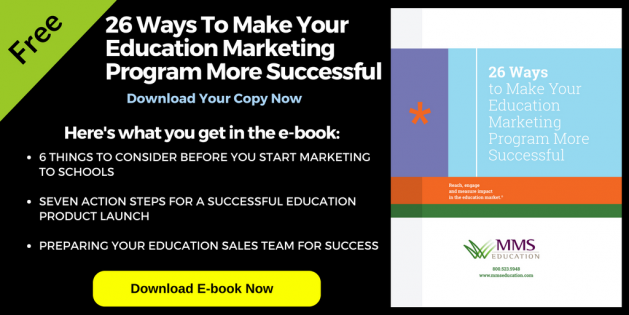By Susan Meell, CEO, MMS Education
Susan Meell recently hosted a roundtable at EdNET 2017 to discuss how to set your brand apart in the crowded education marketplace using competitive advantages. This blog highlights some of the key points discussed.
The education market is highly competitive with products and programs sharing many similarities. One of the keys to success is learning how to differentiate your brand, identify your competitive advantages, and use them to your advantage. Not sure you know your competitive advantages? In many cases, you can use data and research to help shape or even create your competitive advantages—and make your incredible story even more remarkable and unique. But before you can identify your competitive advantages, you need to know what they are and what they are not.
First of all, a competitive advantage is a unique feature or element offered by a company or product that its competitors do not have. It’s what makes you “S.U.D.”—singular, unique, and different. The best test I have seen to help companies identify their competitive advantages is to answer the “only” question. What can you say about your product or company that no one else can say? For instance, “We are the only company that does ______”or the “only literacy program that offers ______.” If you can make an “only” statement about something that is meaningful and of value to your customers, that is a competitive advantage.
Why do competitive advantages matter? Not only do they set you apart from the competition, but they also allow you to either generate greater sales and better profit margins or retain more customers than your competitors. They increase your value proposition and help you avoid the tendency to sell only on price (which often leads to deep discounting). There are many different types of competitive advantages, most of which are connected to:
- Cost structures
- Product offerings
- Distribution network
- Extra value (think bundled professional development, teacher support, student tutoring)
- Customer service, technical support or implementation support
In general, competitive advantages are either comparative (cost advantages) or differential (showing how you are different, unique).
The important thing to remember is competitive advantages should be objective—not subjective—and quantifiable—not arbitrary. AND they can’t be claimed by your competitors. For instance, look how much stronger a competitive advantage becomes when it is defined and stated with quantifiable specifics:
Objective, not subjective
“We return every customer’s call within an hour,” not “We deliver great customer service.”
Quantifiable, not arbitrary
“95% of our customers renew every year,” not “Our customers love our reading program.”
Is not a cliché
“90% of all new business comes from referrals,” not “We exceed our customers’ expectations.”
The key to discovering your competitive advantage is to find out what really matters to your customers and what is of high value to them. Don’t assume you know what is important to them. They may place a high value on certain aspects of your program that you don’t know they value. It could be the way the program is packaged, your exceptional customer service or technical support, or other features that you may not even realize. And don’t assume that what is a competitive advantage for the end user (for instance, a teacher) will be the same competitive advantage for a decision maker (for example, an administrator). While a teacher may value certain aspects of a product or program such as ease of use, an administrator may find value in something quite different—for example, research showing improved student test scores, or complete training and implementation included in the offer.
How can you learn what really matters to your customers? One way is to conduct unbiased, third-party research using in-depth interviews, customer surveys, or other research methodologies to uncover your customers’ true thoughts. Another way is to monitor social media for your own product and those of your competitors, following posts and comments to see what customers love or hate about products and companies.
The key to setting your brand apart is to define your competitive advantages in a clear, specific way and use research and data to strengthen your claims. Not sure you have any competitive advantages? Then it may be time to create some! In our next blog, we’ll share different ways you can develop and create your own competitive advantages.
MMS Education can help you identify your competitive advantages, analyze your data, and conduct customer research to learn why and how customers value your product compared to those of your competitors. Call us today at 866-382-6116 or fill out this form to see how MMS Education can help you.

